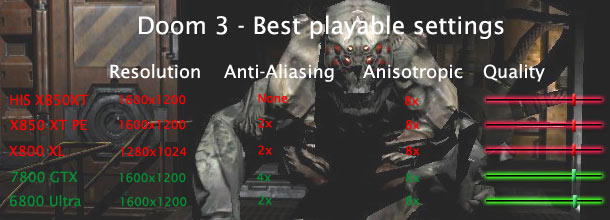Doom 3
Publisher: ActivisionWe are using the full retail version of Doom 3 patched to version 1.1 and we used a section of the “Caverns” level to do a manual run through for the purposes of this comparison. Anti-Aliasing and Anisotropic Filtering were configured from inside the game, and thus we've left the drivers set to “Application Controlled”.
Due to the darkness of Doom 3, we find that increasing the resolution has greater image quality benefits than applying AA to a lower resolution.
Below is a table of the best-playable settings that we found best for each video card configuration. In this title, we found that 25 to 30 frames per second minimum and a target of 52 frames per second (or higher) for the average frame rate delivered smooth and very playable game play.

Doom 3 really is NVIDIA's baby, and it is also the one game that we tested, where we found that we were able to increase the in-game image quality when we set the enhanced iTurbo clock speeds on the HighTech Radeon X850 XT. With the card running at its default clock speeds, we found that we were able to experience smooth game play at 1600x1200 0xAA 8xAF. When we enabled the enhanced iTurbo clock speeds, we found that we were able to increase the settings to 1600x1200 2xAA 8xAF while still retaining a smooth gaming experience.
We lost a single frame per second on the average frame rate and two frames per second, down to 24 frames per second minimum frame rate through our manual run through. The difference in smoothness was not noticeable, while the increase in image quality was noticeable.
The GeForce 7800 GTX was the fastest card on test allowing for smooth game play at 1600x1200 4xAA 8xAF with High Quality in-game details, while the 6800 Ultra delivered roughly the same gaming experience as the HighTech Radeon X850 XT when it was operating at its enhanced clock speeds. It was slightly smoother, but we come to expect that in this title.

MSI MPG Velox 100R Chassis Review
October 14 2021 | 15:04








Want to comment? Please log in.